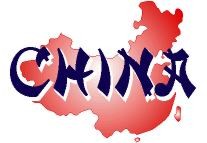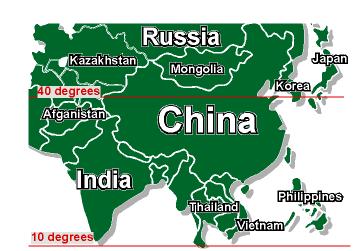|
What do a hair dryer, mobile
phone, shoe, shirt, and various toys all have in common? Look on the
bottom. Chances are—they all came from China. Obviously, China is an
integral part of each of our lives.
The graphics on this page
show China’s population and location. China has the world's largest
population (close to 1.5 billion), and is slightly larger than the USA in
area. Much of China is in the desert or mountains, so two-thirds of the
people live in the eastern third of the country. Over 90% of the
population is “Han” Chinese, but the nation also recognizes 56 ethnic
groups.
The Chinese trace their
history back 6000 years - longer than almost any other culture. Her
writing system was among the world’s first, and it remains among the most
difficult to learn! The Great Wall is over 2000 years old and could
stretch from Atlanta to Los Angeles (or London to Istanbul).
Since we moved to China
in 2000, we have lived in four cities. (Michael also lived in Xiamen and
Beijing in the 1980s.)
Shanghai
(where we lived from 2000-2002) is a thriving industrial city near the
mouth of the Yangtze River, complete with 21 million people (ChinaDaily
2013), two of the tallest buildings in the world, beautiful parks,
continuous construction, modern shopping centers, a 400-year-old tea
house, a proud past, and a promising future. The climate is often windy
and/or hazy, and Shanghai's rapid growth also means there is plenty of
dust and pollution in the air. Economically, if current trends continue it
could soon outrank Hong Kong and Tokyo as the economic capital of Asia.
Xi'an
(where we lived from 2002-2005) is a former Chinese capital with a rich
history and growing contemporary importance. Some 6000 years ago, a
female-dominated tribe lived nearby. Over 2000 years ago, Emperor Qin Shi
Huan buried hundreds of life-size clay statues around his tomb (discovered
in the 1960s, this and other local tombs have provided important clues
into China's past). With over 8.5 million people (Shanxi.gov 2012), Xi'an
shares some of Shanghai's "growing pains," especially in terms of dust and
pollution, but the city is also getting a lot of attention as a developing
center for high-tech industries and the "door" to China's vast central and
western regions. |
(continued)
Kunming
(2005-2010) has a better climate than anyplace we've ever lived. Although
it has a month of near-freezing weather (and no indoor heat), most of the
year is closer to the max temperature of 24C/75F. “Spring City” has over 7
million people (Xinhuanet 2012), and we noticed increasing traffic jams
and concomitant pollution. Yunnan Province borders Vietnam, Laos and
Myanmar, and is the proud home of 26 ethnic minorities. The area has been
an important trade route for 2400 years, first as part of the "tea-horse
road" (or southern Silk Road) and in World War 2 as the start of the
Burma Road.
Kunming's residents enjoy blue skies, the nearby Stone Forest, locally
produced Pu-er tea and "Across the Bridge Rice Noodles."
After a year in the US, we moved to
Xiamen (2011-present), a growing center for learning, trade and
tourism. Michael studied Mandarin here 1985-87, and his teachers say it's
great to have a former student on the faculty of their top-ranked
university! ChinaDaily (2012) said that the population grew from 1.5 to
4.5 million between 2000 and 2012; that kind of growth (plus the city's
million-plus vehicles) is hard to manage, so roads are often clogged and
the skies are increasingly hazy. But Xiamen is still considered a top
investment & trade center, a popular tourist port, and one of China's
“most livable cities.” Features include a Bahamas-like climate (sweltering
summer, rainy typhoon season, but long spring and fall), beautiful beaches
and flowers, historic architecture, a thriving economic zone, a famous
trade fair, and high-speed rail service to both Shanghai and Shenzhen/Hong
Kong.
Experts worldwide agree that
China's importance will continue to increase, but only “heaven knows” how
that will affect the rest of the world. As China's economy continues to
expand, it struggles to shift from being export-dominated to
consumer-oriented. The signs of modernization are everywhere, from
classrooms and factories to e-commerce and communications systems. But
serious issues also face Chinese experts, including the cost of housing,
stability in marriage, environmental pollution and sustainable growth. In
15-20 years—maybe less—China will have the largest economy in the world,
as well as the world’s largest population.
The kinds of relationships which are now being
formed between China and the West will help determine whether they exist
as mutual threats or valued friends. We believe that sowing friendship and
seeking to help meet China's needs through service will help make the
world a better place, and that's why we moved here to teach English!
People all over China are begging for English teachers and
English-language courses in recognition of the role English plays in
trade, travel, medicine and technology. By touching key people on their
way up the professional ladder, we believe we can play an important part
in shaping the future. We feel that friendship, cooperation, and the Light
of Love are our best hope for transpacific tranquility in these early
decades of the new millennium.
Michael Krigline
(2002, revised 2014)
About us (frequently asked questions) |

